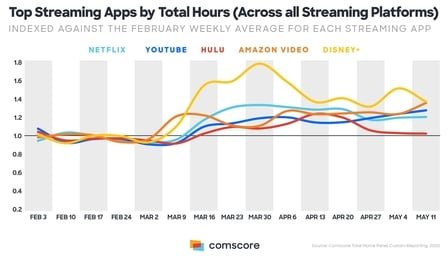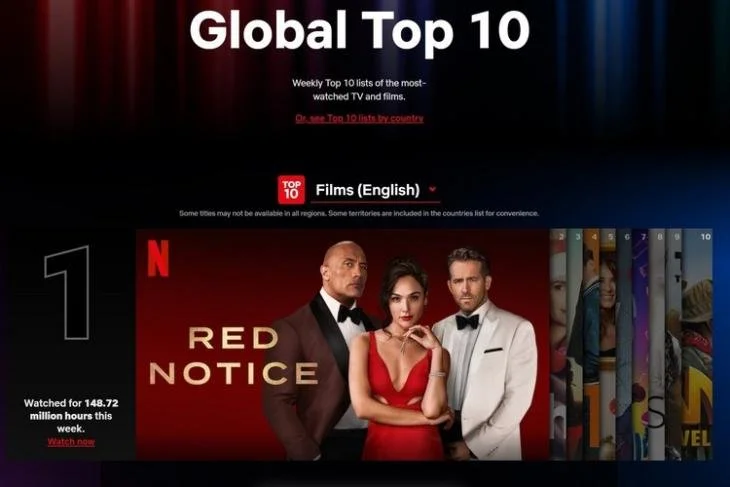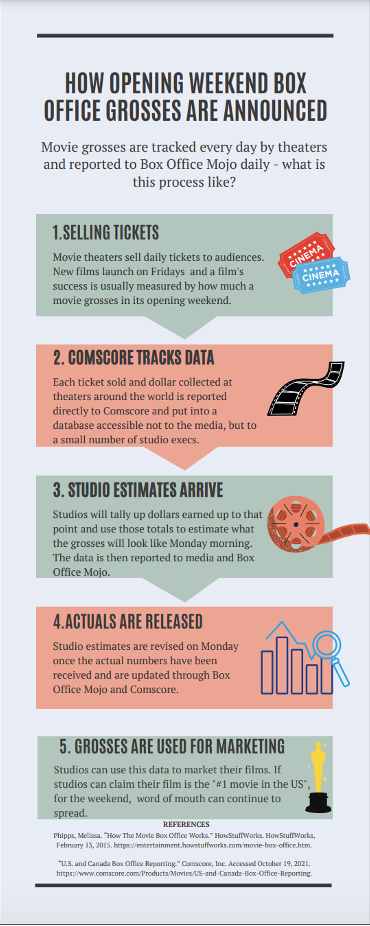Audience Consumption Data for Films and Television
Since the 1980s, it has been industry practice to measure the number of viewers consuming films and television. These measures affect the industry in multiple ways, from advertising sales to cultivating future viewers, and often contribute to the project’s success. For films released in movie theaters, measurement is determined through box-office grosses, which counts the amount of dollars earned per movie in ticket revenue. Box Office Mojo tracks this box-office revenue daily, in a systematic, algorithmic way. For linear television programming, measurement is determined through Nielsen ratings, an accredited system that determines the audience size for all linear cable and network programming.
The Launch of Streaming Services and Series Programming
In 2013, Netflix debuted its first original television program: House of Cards. The show was only available via streaming, which is something that most mainstream audiences across the world were not used to. Thanks to its A-list stars and awards-buzz, the show helped audiences everywhere familiarize themselves with the idea of streaming. Netflix continued to produce essential viewing television programs such as Orange Is The New Black and Stranger Things on its streaming platform, where one could view these shows for only $5.99 a month.
Hulu and Amazon Prime Video followed suit by producing similar business strategies for their streaming service platforms. A few years later, studios and media companies started creating their own streaming services in a domino effect. As the COVID-19 pandemic set into place, streaming consumption thrived. Studios began to capitalize on consumers being at home, and launched their own streaming services. By the end of 2020, major streaming services were everywhere -- this included Disney Plus, HBO Max, Peacock, Paramount Plus, Discovery Plus, and Apple TV Plus.
Source: Comscore
By the end of 2020, streaming became normalized for film and television consumption. In the United States, throughout all of 2020, movie theaters were closed, resulting in films being watched solely via streaming, cable, and broadcast television. But the move to normalization began earlier. In 2019, a Motion Picture Association of America report concluded that streaming services overtook cable in subscriptions between 2017 and 2018. And in May 2021, Nielsen reported that streaming consumption overtook broadcast television in overall consumption -- a first.
Streaming, however, has never had a meter for audience consumption and viewership. Studios, networks and dedicated platforms like Netflix have control of the data and the power to release streaming audience consumption reports however and whenever they want.
Studio Viewership Reporting Methods
Since streaming platforms launched, there has been a precedent that studios do not release official audience measurement data. There are no official reports of how many viewers any particular show receives on streaming services. If it wasn’t already clear from skyrocketing streaming statistics and the company-wide reorganization of executives at streaming parent companies (WarnerMedia, Viacom CBS, NBCUniversal, Walt Disney), streaming is very much the future. That means the push to bridge the measurement and currency gaps between traditional linear television and the rapidly accelerating streaming space has never been more frantic.
Although major streamers do not regularly release their own verifiable viewership data, Nielsen started attempts to measure streaming data in 2017. Many studios have started to use Nielsen streaming ratings to boast about numbers, but Nielsen only has limited access to certain data points. Nielsen’s data is only based on United States audiences using TV sets and only covers Netflix, Amazon Prime Video, Hulu, and Disney Plus. The company releases its streaming data reports on a roughly one-month delay due to an arrangement with the aforementioned streaming services.
Netflix has a history of coming out against Nielsen’s reporting methodology as well as other third-party reports of audience measurement for the studio. Netflix titles were first measured in viewership by Nielsen in 2017. Netflix released a statement when the first ratings came out via Nielsen that read: ““The data that Nielsen is reporting is not accurate, not even close, and does not reflect the viewing of these shows on Netflix.”
Additionally, there are times when major studios have announced streaming service grosses (Universal’s Trolls World Tour, Disney’s Black Widow) for differing reasons. But without context of comparable data, these reports have done little to benefit the industry at large, particularly in the case of Disney’s.
Why does consumption reporting matter?
There will always be reasons why streaming services keep their internal viewership data under wraps, but the benefits of accurate viewership statistics would be to inform the industry and drive more informed decision making overall. As streaming services move out of infancy and are treated as legitimately powerful Big Tech companies i.e. Facebook and Google, they will need specific data to back up their claims and to build rapport and trust with their audience. Proving success through viewership data has historically driven audiences to titles they wouldn’t normally select.
As companies rely more on data to tell them where to invest and what to avoid, being able to see those numbers is crucial to the entertainment industry as it heads into a new direction. The landscape of the industry is heavily shifting, and data is the most important tool that can guide these companies in the right direction in terms of content strategy, product enhancement, budgeting, and use of technology.
Right now, companies that own major streaming services have kept the data surrounding viewership of their streamable shows and films completely secret. Only employees within the company can utilize this crucial data, which has not been the precedent for films released in theaters and television programming that is released linearly. The industry at large has been kept in the dark by not understanding what specific types of television shows and films are connecting with streaming audiences, and what types of content is not connecting. This is a lost opportunity according to Diertich von Buren, Chief Business Officer at ReelGood, who said in a statement: “Viewership itself is not a secret formula or silver bullet, it’s just a measure of success. Strong viewership is simply an indicator of popular content and the opposite holds true, so let the market learn from it and not hide from it. Streaming services will benefit and so will consumers.”
This statement, and many similar ones made by experts in the industry, point to an understanding that there needs to be more transparency in viewership data from these streaming services. If viewership data was released publicly, data scientists could pull together more accurate and streamlined predictions and understandings of streaming audiences. This could lead to a stronger understanding of what types of content to produce and develop, as well as stronger methodologies for expanding streaming audiences at large.
Effects on Artists Paid on Contingent
In July 2021, Disney released its latest big-budget Marvel film Black Widow, starring Scarlett Johansson, in theaters and on Disney Plus on the same day. Like many movie stars, Johansson initially signed a contingent payment contract with Disney. This meant that she would earn a percentage of her wages from the total profit of the film. However, Johansson was not aware of the plan to release the film on streaming services and in theaters. On its opening weekend Black Widow grossed $80 million in theaters. For comparison, another standalone Marvel film, Black Panther, grossed $202 million in its opening weekend.
Source: Box Office Mojo
However, this weekend marked the first time a major streaming service announced streaming grosses for a film -- Disney reported that 2 million subscribers (out of 100 million total subscribers) paid $30 to view the film on Disney Plus, resulting in another $60 million. While these numbers may seem favorable, the film dropped 67% in its second weekend in theaters, grossing $26 million. This was the steepest drop ever for a film in the Marvel Cinematic Universe, and many analysts (and Scarlett Johansson) believed it was because of the simultaneous theatrical and streaming release.
On July 29th, Johansson sued Disney for “intentionally inducing Marvel’s breach of the agreement, without justification, in order to prevent Johansson from realizing the full benefit of her bargain with Marvel”. This is an example of how the privacy and inconsistencies in audience consumption data can negatively affect all parties involved. Ironically, this lawsuit was settled on October 1st, but no details were released about the agreement. Johansson released a statement saying that she was happy that differences were resolved and excited to work together further in the future.
The Future of Viewership Data in the Entertainment Industry
Despite the majority of viewership data being held between the teams at various streaming and distribution companies, some companies have begun slowly churning out statistics that hint at the impact their content is having on the disruption of the streaming industry. In November 2021,Netflix became the first company to release its own form of viewership data that includes consistent data. Netflix launched a website that shows their Top 10 most streamed films and television shows each week, as well as the total number of hours viewed for each of these entities. Although it is too early to tell the ripple effects that this list will have on the industry, it seems to suggest that third-party measurement systems such as Nielsen will be less justifiable if other streaming services follow this trend..
Source: Netflix
Netflix has 214 million subscribers, far more than any other streaming service, and therefore had the least to lose by being the first to announce viewership data of its own films and shows. This is a signal that as streaming continues to pivot the entertainment industry, other services will begin to release viewership data in a similar fashion. This crucial step in releasing streaming viewership data has the potential to set a new dawn for streaming services: one where data and transparency lead the way into a more informed and impactful industry.
How Opening Weekend Box Office Grosses are Announced. Infographic by author.
+ Resources
Adgate, B. “What Will The Future Of Audience Measurement Be: Executives From Ad Tech Providers Respond”. Forbes. September 21, 2021. https://www.forbes.com/sites/bradadgate/2021/09/21/what-will-the-future-of-audience-measurement-be-executives-from-ad-tech-providers-respond/amp/?sh=50f73cc122cf&__twitter_impression=true.
“The Age of Streaming Services: Then, Now, and Beyond.” The Artifice. Accessed October 20, 2021. https://the-artifice.com/history-of-streaming/.
Alexander, Julia. “Trolls World Tour Made Nearly $100 Million without Theaters, but Theaters Aren't Obsolete.” The Verge. The Verge, April 29, 2020. https://www.theverge.com/2020/4/29/21239703/trolls-world-tour-amc-digital-streaming-theaters-nbcuniversal-disney-warnerbros.
Barnes, B., & Sperling, N. (2021, September 5). “How's Hollywood To Plan When It Doesn't Know Who's WATCHING WHAT?” The New York Times. September 27, 2021. https://www.nytimes.com/2021/09/05/business/box-office-movie-ratings.html.
Bloomberg.com. Bloomberg. Accessed October 20, 2021. https://www.bloomberg.com/news/articles/2021-01-21/netflix-hbo-max-streaming-is-hurting-actors-producers-big-paychecks.
D'Alessandro, Anthony. “'Black Widow' Posts Steepest 2nd Weekend B.O. Drop for Disney MCU Title; Studio Silent on PVOD Update as Piracy Impacts Pic.” Deadline. Deadline, July 18, 2021. https://deadline.com/2021/07/black-widow-mcu-record-second-weekend-box-office-drop-disney-piracy-1234795325/.
Hoium, Travis. “What Is the Future of Streaming TV?” The Motley Fool. The Motley Fool, September 22, 2021. https://www.fool.com/investing/2021/09/22/what-is-the-future-of-streaming-tv/.
“Home.” Box Office Mojo. Accessed October 20, 2021. https://www.boxofficemojo.com/.
Hulu Advertising. (2020, December 16). Looking back on 2020: Hulu's year end report. Most Watched Movies. October 5, 2021. https://advertising.hulu.com/2020/12/16/looking-back-on-2020-hulus-year-end-report/.
Katz, B. (2021, July 27). How many viewers are actually WATCHING 'Ted LASSO' season 2? Observer. September 27, 2021. https://observer.com/2021/07/apple-tv-plus-ted-lasso-season-2-viewership-ratings-audience/.
Keck, Catie. “Netflix Launches New Website for Reporting Its Top 10 Titles.” The Verge. The Verge, November 16, 2021. https://www.theverge.com/2021/11/16/22785623/netflix-launches-top-10-titles-website.
Koblin, John. “How Many People Watch Netflix? Nielsen Tries to Solve a Mystery.” The New York Times. The New York Times, October 18, 2017. https://www.nytimes.com/2017/10/18/business/media/nielsen-netflix-viewers.html?action=click&module=RelatedCoverage&pgtype=Article®ion=Footer.
Koblin, John. “Netflix's Opaque Disruption Annoys Rivals on TV.” The New York Times. The New York Times, January 18, 2016. https://www.nytimes.com/2016/01/18/business/media/disruption-by-netflix-irks-tv-foes.html
Masters, Kim. “Scarlett Johansson, Disney Settle Explosive 'Black Widow' Lawsuit.” The Hollywood Reporter. The Hollywood Reporter, October 7, 2021. https://www.hollywoodreporter.com/business/business-news/scarlett-johansson-disney-settle-black-widow-lawsuit-1235022598/.
McClintock, Pamela. (2020, November 3). Box Office reporting may be "forever changed" due to pandemic. The Hollywood Reporter. October 5, 2021. https://www.hollywoodreporter.com/movies/movie-news/box-office-reporting-may-be-forever-changed-due-to-pandemic-4084993/.
McClintock, Pamela. “Box Office: 'Black Widow' Spins Record $80m U.S. Opening, Earns $60m on Disney+ Premier Access.” The Hollywood Reporter. The Hollywood Reporter, July 13, 2021. https://www.hollywoodreporter.com/movies/movie-news/black-widow-box-office-disney-milestone-opening-1234980531/#:~:text=Box%20Office%3A%20'Black%20Widow',streaming%20numbers%20on%20opening%20weekend.
Miller, James. “Streaming Subscriptions Surpassed Cable Worldwide in 2018.” TechSpot. TechSpot, March 23, 2019. https://www.techspot.com/news/79333-streaming-subscriptions-surpassed-cable-worldwide-2018.html.
Muskan. (n.d.). Big data in media and entertainment industry. Analytics Steps. September 27 2021.https://www.analyticssteps.com/blogs/big-data-media-and-entertainment-industry.
Nielsen. “Top 10s: TV Ratings, Video Games, SVOD.” Nielsen. November 13, 2021. https://www.nielsen.com/us/en/top-ten/.
Phipps, Melissa. “How The Movie Box Office Works.” HowStuffWorks. HowStuffWorks, February 13, 2015. https://entertainment.howstuffworks.com/movie-box-office.htm.
Salkowitz, R. (2021, September 20). Podcasts are hot, bingeing is down, per new survey of American Media Consumption. Forbes. October 5, 2021. https://www.forbes.com/sites/robsalkowitz/2021/09/20/podcasts-are-hot-bingeing-is-down-per-new-survey-of-american-media-consumption/?sh=44c160d25159.
Shaw, Lucas. “Dave Chappelle's Special Cost More Than 'Squid Game'.” Bloomberg.com. Bloomberg, October 17, 2021. https://www.bloomberg.com/news/newsletters/2021-10-17/dave-chappelle-s-special-cost-more-than-squid-game.
Steinberg, Brian. “Nielsen, TV Networks Clash over Coronavirus Viewership, and the Future.” Variety. Variety, May 4, 2021. https://variety.com/2021/tv/news/nielsen-tv-networks-ratings-coronavirus-1234962609/.
Steinberg, Brian. “Nielsen's National Ratings Accreditation Suspended by Media Rating Council.” Variety. Variety, September 1, 2021. https://variety.com/2021/tv/news/nielsen-national-ratings-suspension-media-rating-council-1235053949/.
“U.S. and Canada Box Office Reporting.” Comscore, Inc. Accessed October 19, 2021. https://www.comscore.com/Products/Movies/US-and-Canada-Box-Office-Reporting.
“U.S. Theatrical Distribution System.” Comscore, Inc. Accessed October 20, 2021. https://www.comscore.com/Products/Movies/U.S.-Theatrical-Distribution-System. Walker, Sophie. “How Useful Are TV Show Ratings for Brands Today?” Talkwalker, September 9, 2020. https://www.talkwalker.com/blog/how-useful-are-tv-show-ratings-for-brands-today.





